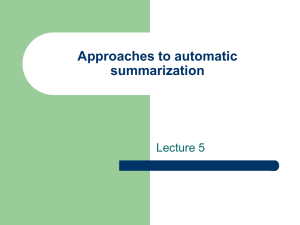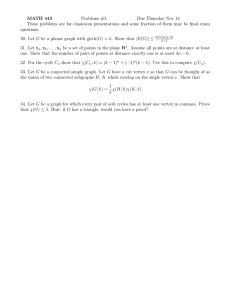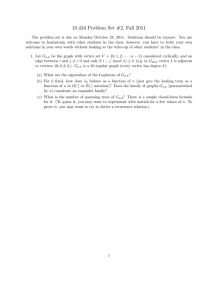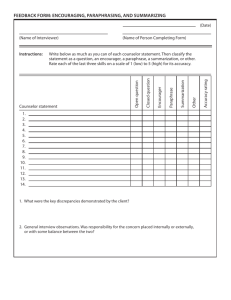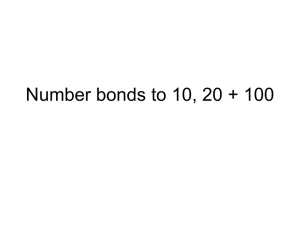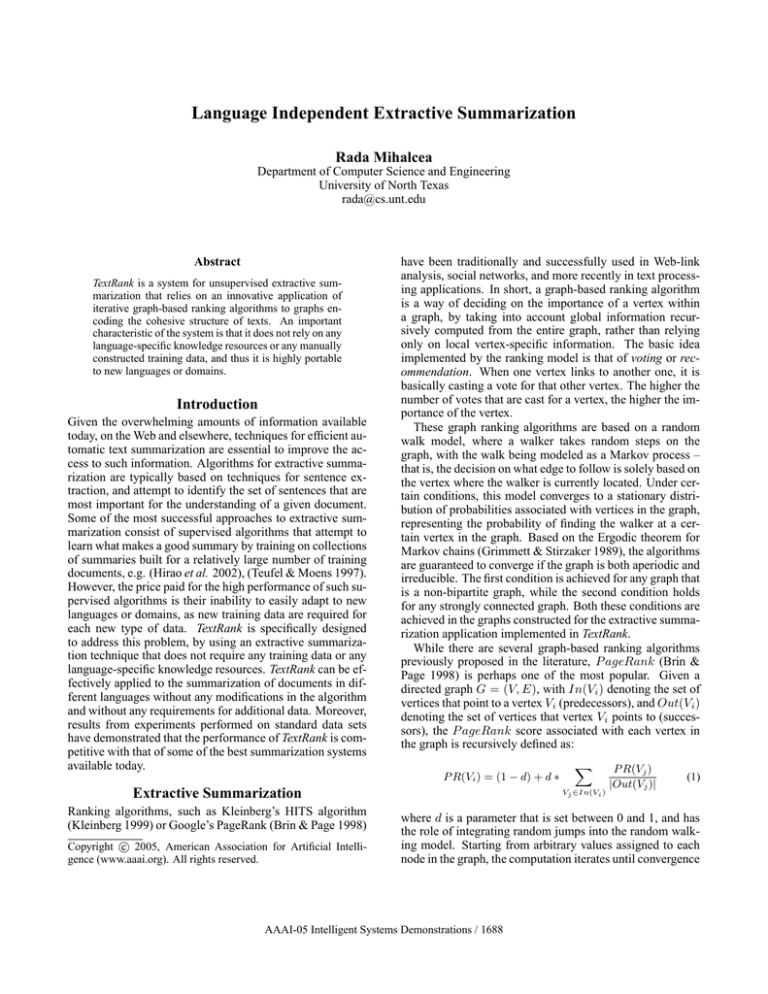
Language Independent Extractive Summarization
Rada Mihalcea
Department of Computer Science and Engineering
University of North Texas
rada@cs.unt.edu
Abstract
TextRank is a system for unsupervised extractive summarization that relies on an innovative application of
iterative graph-based ranking algorithms to graphs encoding the cohesive structure of texts. An important
characteristic of the system is that it does not rely on any
language-specific knowledge resources or any manually
constructed training data, and thus it is highly portable
to new languages or domains.
Introduction
Given the overwhelming amounts of information available
today, on the Web and elsewhere, techniques for efficient automatic text summarization are essential to improve the access to such information. Algorithms for extractive summarization are typically based on techniques for sentence extraction, and attempt to identify the set of sentences that are
most important for the understanding of a given document.
Some of the most successful approaches to extractive summarization consist of supervised algorithms that attempt to
learn what makes a good summary by training on collections
of summaries built for a relatively large number of training
documents, e.g. (Hirao et al. 2002), (Teufel & Moens 1997).
However, the price paid for the high performance of such supervised algorithms is their inability to easily adapt to new
languages or domains, as new training data are required for
each new type of data. TextRank is specifically designed
to address this problem, by using an extractive summarization technique that does not require any training data or any
language-specific knowledge resources. TextRank can be effectively applied to the summarization of documents in different languages without any modifications in the algorithm
and without any requirements for additional data. Moreover,
results from experiments performed on standard data sets
have demonstrated that the performance of TextRank is competitive with that of some of the best summarization systems
available today.
have been traditionally and successfully used in Web-link
analysis, social networks, and more recently in text processing applications. In short, a graph-based ranking algorithm
is a way of deciding on the importance of a vertex within
a graph, by taking into account global information recursively computed from the entire graph, rather than relying
only on local vertex-specific information. The basic idea
implemented by the ranking model is that of voting or recommendation. When one vertex links to another one, it is
basically casting a vote for that other vertex. The higher the
number of votes that are cast for a vertex, the higher the importance of the vertex.
These graph ranking algorithms are based on a random
walk model, where a walker takes random steps on the
graph, with the walk being modeled as a Markov process –
that is, the decision on what edge to follow is solely based on
the vertex where the walker is currently located. Under certain conditions, this model converges to a stationary distribution of probabilities associated with vertices in the graph,
representing the probability of finding the walker at a certain vertex in the graph. Based on the Ergodic theorem for
Markov chains (Grimmett & Stirzaker 1989), the algorithms
are guaranteed to converge if the graph is both aperiodic and
irreducible. The first condition is achieved for any graph that
is a non-bipartite graph, while the second condition holds
for any strongly connected graph. Both these conditions are
achieved in the graphs constructed for the extractive summarization application implemented in TextRank.
While there are several graph-based ranking algorithms
previously proposed in the literature, P ageRank (Brin &
Page 1998) is perhaps one of the most popular. Given a
directed graph G = (V, E), with In(Vi ) denoting the set of
vertices that point to a vertex Vi (predecessors), and Out(Vi )
denoting the set of vertices that vertex Vi points to (successors), the P ageRank score associated with each vertex in
the graph is recursively defined as:
P R(Vi ) = (1 − d) + d ∗
Extractive Summarization
Ranking algorithms, such as Kleinberg’s HITS algorithm
(Kleinberg 1999) or Google’s PageRank (Brin & Page 1998)
c 2005, American Association for Artificial IntelliCopyright gence (www.aaai.org). All rights reserved.
X
Vj ∈In(Vi )
P R(Vj )
|Out(Vj )|
(1)
where d is a parameter that is set between 0 and 1, and has
the role of integrating random jumps into the random walking model. Starting from arbitrary values assigned to each
node in the graph, the computation iterates until convergence
AAAI-05 Intelligent Systems Demonstrations / 1688
below a given threshold is achieved. After running the algorithm, a score is associated with each vertex, which represents the importance of that vertex within the graph. Note
that the final scores are not affected by the choice of initial
vertex values, only the number of iterations to convergence
may be different.
When the graphs are built starting with natural language
texts, it may be useful to integrate into the graph model the
strength of the connection between two vertices Vi and Vj
indicated as a weight wij added to the corresponding edge.
The ranking algorithm was thus adapted to include edge
weights:
X
P RW (Vj )
P
(2)
P RW (Vi ) = (1−d)+d∗
wji
wkj
Vj ∈In(Vi )
Vk ∈Out(Vj )
For the task of single-document extractive summarization,
the goal is to rank the sentences in a given text with respect
to their importance for the overall understanding of the text.
A graph is therefore constructed by adding a vertex for each
sentence in the text, and edges between vertices are established using sentence inter-connections. These connections
are defined using a similarity relation, where “similarity” is
measured as a function of content overlap. Such a relation
between two sentences can be seen as a process of recommendation: a sentence that addresses certain concepts in a
text gives the reader a recommendation to refer to other sentences in the text that address the same concepts, and therefore a link can be drawn between any two such sentences
that share common content.
The overlap of two sentences can be determined simply
as the number of common tokens between the lexical representations of the two sentences, or optionally it can be
run through filters that e.g. eliminate stopwords, count only
words of a certain category, etc. Moreover, to avoid promoting long sentences, we are using a normalization factor, and
divide the content overlap of two sentences with the length
of each sentence.
The resulting graph is highly connected, with a weight associated with each edge, indicating the strength of the connections between various sentence pairs in the text. The
graph can be represented as: (a) simple undirected graph;
(b) directed weighted graph with the orientation of edges set
from a sentence to sentences that follow in the text (directed
forward); or (c) directed weighted graph with the orientation
of edges set from a sentence to previous sentences in the text
(directed backward).
After the ranking algorithm is run on the graph, sentences
are sorted in reversed order of their score, and the top ranked
sentences are selected for inclusion in the extractive summary.
Evaluation
TextRank was evaluated on two standard summarization data
sets consisting of newspaper articles in English and Portuguese. For English, the evaluation was conducted on 567
English news articles made available during the Document
Understanding Evaluations 2002 (DUC 2002). For Portuguese, we used the TeMário data set, consisting of 100
Data set
English
Portuguese
Undirected
0.4904
0.4939
Graph
Forward
0.4202
0.4574
Backward
0.5008
0.5121
Baseline
0.4799
0.4963
Table 1: Evaluation of TextRank extractive summaries.
documents from Brazilian newspapers (Pardo & Rino 2003).
Regardless of the language, the evaluation was performed
using the ROUGE evaluation toolkit (Lin & Hovy 2003).
Table 1 shows the results obtained on both data sets for different graph settings. The table also lists baseline results, obtained on summaries generated by taking the first sentences
in each document. By ways of comparison, the best participating system in DUC 2002 was a supervised system that
led to a ROUGE score of 0.5011.
The results are encouraging: for both data sets, TextRank
applied on a directed backward graph structure exceeds by a
large margin the performance achieved through a simple (but
competitive) baseline. These results prove that graph-based
ranking algorithms, previously found successful in Web link
analysis and social networks, can be turned into a state-ofthe-art tool for extractive summarization when applied to
graphs extracted from texts. Moreover, due to its unsupervised nature, the algorithm was also shown to be language
independent, leading to similar results and similar improvements over baselines when applied on documents in different languages. More extensive experimental results with the
TextRank system are reported in (Mihalcea & Tarau 2004),
(Mihalcea & Tarau 2005).
References
Brin, S., and Page, L. 1998. The anatomy of a large-scale hypertextual Web search engine. Computer Networks and ISDN Systems 30(1–7).
DUC.
2002.
Document understanding conference 2002.
http://www-nlpir.nist.gov/projects/duc/.
Grimmett, G., and Stirzaker, D. 1989. Probability and Random
Processes. Oxford University Press.
Hirao, T.; Sasaki, Y.; Isozaki, H.; and Maeda, E. 2002. Ntt’s
text summarization system for duc-2002. In Proceedings of the
Document Understanding Conference 2002.
Kleinberg, J. 1999. Authoritative sources in a hyperlinked environment. Journal of the ACM 46(5):604–632.
Lin, C., and Hovy, E. 2003. Automatic evaluation of summaries
using n-gram co-occurrence statistics. In Proceedings of Human
Language Technology Conference (HLT-NAACL 2003).
Mihalcea, R., and Tarau, P. 2004. TextRank – bringing order into
texts. In Proceedings of the Conference on Empirical Methods in
Natural Language Processing (EMNLP 2004).
Mihalcea, R., and Tarau, P. 2005. Iterative graph-based algorithms for language independent extractive summarization. (submitted).
Pardo, T., and Rino, L. 2003. TeMario: a corpus for automatic
text summarization. Technical report, NILC-TR-03-09.
Teufel, S., and Moens, M. 1997. Sentence extraction as a classification task. In ACL/EACL workshop on ”Intelligent and scalable
Text summarization”, 58–65.
AAAI-05 Intelligent Systems Demonstrations / 1689

